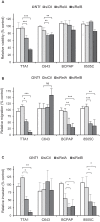NF-κB signaling activation and roles in thyroid cancers: implication of MAP3K14/NIK
- PMID: 37973791
- PMCID: PMC10654696
- DOI: 10.1038/s41389-023-00496-w
NF-κB signaling activation and roles in thyroid cancers: implication of MAP3K14/NIK
Abstract
Among follicular-derived thyroid cancers (TC), those with aggressive behavior and resistance to current treatments display poor prognosis. NF-κB signaling pathways are involved in tumor progression of various cancers. Here, we finely characterize the NF-κB pathways and their involvement in TC. By using immunoblot and gel shift assays, we demonstrated that both classical and alternative NF-κB pathways are activated in ten TC-derived cell lines, leading to activated RelA/p50 and RelB/p50 NF-κB dimers. By analyzing the RNAseq data of the large papillary thyroid carcinoma (PTC) cohort from The Cancer Genome Atlas (TCGA) project, we identified a tumor progression-related NF-κB signature in BRAFV600E mutated-PTCs. That corroborated with the role of RelA and RelB in cell migration and invasion processes that we demonstrated specifically in BRAFV600E mutated-cell lines, together with their role in the control of expression of genes implicated in invasiveness (MMP1, PLAU, LCN2 and LGALS3). We also identified NF-κB-inducing kinase (NIK) as a novel actor of the constitutive activation of the NF-κB pathways in TC-derived cell lines. Finally, its implication in invasiveness and its overexpression in PTC samples make NIK a potential therapeutic target for advanced TC treatment.
© 2023. The Author(s).
Conflict of interest statement
The authors declare no competing interests.
Figures







Similar articles
-
Tumor necrosis factor-like weak inducer of apoptosis (TWEAK) promotes glioma cell invasion through induction of NF-κB-inducing kinase (NIK) and noncanonical NF-κB signaling.Mol Cancer. 2015 Jan 27;14(1):9. doi: 10.1186/s12943-014-0273-1. Mol Cancer. 2015. PMID: 25622756 Free PMC article.
-
BRAFV600E mutation, TIMP-1 upregulation, and NF-κB activation: closing the loop on the papillary thyroid cancer trilogy.Endocr Relat Cancer. 2011 Nov 14;18(6):669-85. doi: 10.1530/ERC-11-0076. Print 2011 Dec. Endocr Relat Cancer. 2011. PMID: 21903858
-
Activation of nuclear factor-κB contributes to growth and aggressiveness of papillary thyroid carcinoma.Pathol Res Pract. 2013 Apr;209(4):228-32. doi: 10.1016/j.prp.2013.02.004. Epub 2013 Mar 5. Pathol Res Pract. 2013. PMID: 23528368
-
Targeting NF-κB-Inducing Kinase (NIK) in Immunity, Inflammation, and Cancer.Int J Mol Sci. 2020 Nov 11;21(22):8470. doi: 10.3390/ijms21228470. Int J Mol Sci. 2020. PMID: 33187137 Free PMC article. Review.
-
BRAF mutation in papillary thyroid carcinoma: pathogenic role and clinical implications.J Chin Med Assoc. 2010 Mar;73(3):113-28. doi: 10.1016/S1726-4901(10)70025-3. J Chin Med Assoc. 2010. PMID: 20230995 Review.
Cited by
-
NIK Is a Mediator of Inflammation and Intimal Hyperplasia in Endothelial Denudation-Induced Vascular Injury.Int J Mol Sci. 2024 Oct 25;25(21):11473. doi: 10.3390/ijms252111473. Int J Mol Sci. 2024. PMID: 39519026 Free PMC article.
-
Oncogenic and tumor-suppressive roles of Lipocalin 2 (LCN2) in tumor progression.Oncol Res. 2025 Feb 28;33(3):567-575. doi: 10.32604/or.2024.051672. eCollection 2025. Oncol Res. 2025. PMID: 40109857 Free PMC article. Review.
-
RBM10 loss promotes metastases by aberrant splicing of cytoskeletal and extracellular matrix mRNAs.J Exp Med. 2025 May 5;222(5):e20241029. doi: 10.1084/jem.20241029. Epub 2025 Feb 24. J Exp Med. 2025. PMID: 39992626
-
The Potential Therapeutic Value of Aspirin in Anaplastic Thyroid Cancer.Cancers (Basel). 2024 Dec 17;16(24):4203. doi: 10.3390/cancers16244203. Cancers (Basel). 2024. PMID: 39766102 Free PMC article.
-
Advances in PD-1/PD-L1 pathway inhibitors in the treatment of thyroid cancer: mechanisms and clinical therapeutic perspectives.Front Immunol. 2025 Aug 8;16:1643421. doi: 10.3389/fimmu.2025.1643421. eCollection 2025. Front Immunol. 2025. PMID: 40861443 Free PMC article. Review.
References
Grants and funding
LinkOut - more resources
Full Text Sources
Research Materials
Miscellaneous

